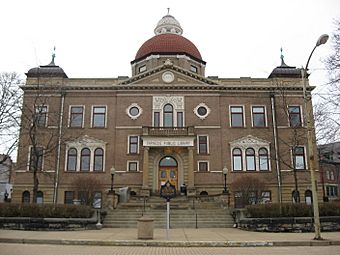Carnegie Public Library (East Liverpool, Ohio) facts for kids
Quick facts for kids Carnegie Public Library (East Liverpool, Ohio) |
|
|---|---|
| Country | United States |
| Established | May 8, 1902 |
| Location | East Liverpool, Ohio |
| Collection | |
| Size | 77414 |
| Access and use | |
| Circulation | 131,634 |
| Population served | 12,396 |
| Other information | |
| Director | Ms. Melissa Percic |
| References: | |

Front of the Carnegie Public Library in downtown East Liverpool, Ohio
|
|
| Location | 219 E. 4th St., East Liverpool, Ohio |
| Area | less than one acre |
| Built | 1900 |
| Architect | Charles Henry Owsley |
| Architectural style | Colonial Revival, Late 19th And 20th Century Revivals, Second Renaissance Revival |
| NRHP reference No. | 80002963 |
| Added to NRHP | March 11, 1980 |
The Carnegie Public Library in East Liverpool, Ohio is a special public library. It is located at 219 East Fourth Street. This library opened its doors in 1902. Its construction was paid for by Andrew Carnegie. He was a very rich businessman who loved to help communities. Carnegie's uncle even lived in East Liverpool! This library was one of the first two libraries in Ohio that Andrew Carnegie helped fund. It became a recognized historic place in March 1980.
How the Library Started
In 1899, two people from East Liverpool, T.Y. Travis and M.E. Miskall, wrote to Andrew Carnegie. They asked him to donate money for a library in their city. Carnegie agreed to give $50,000 for the building. But there was a condition: the city had to provide the land. They also had to promise $3,000 every year to keep the library running.
Citizens of East Liverpool bought the land for the library in August 1899. Construction on the building began in 1900. The library was built with unique brown bricks and white trim. Inside, the lobby has beautiful mosaic tiles. The walls are decorated with Italian marble.
The architect who designed the library was Charles Henry Owsley. He was from Britain and had moved to Ohio. As the library was almost finished, people asked for donations of good books. The first person hired to manage the library was Gertrude A. Baker. She came from Mount Vernon, Ohio.
The Carnegie Public Library officially opened on May 8, 1902. Books from another city library, about 2,505 of them, were moved here. A year later, the library had almost 6,000 books. It also had over 2,000 members. The librarian said the library was so popular that it loaned out more books each month than it actually owned!
Growing Over the Years
For many years, the library faced money problems. But in 1931, it started getting money from the county. Since then, the library has been supported by state and county funds.
In 1907, a local history group opened a museum inside the library. It was on the second floor. Later, they added displays of pottery. These showed items from over 50 local pottery businesses. The museum stayed in the library until the Museum of Ceramics opened in the 1970s.
During World War I, the Red Cross used a room in the library. They worked on projects there, like rolling bandages.
By 1940, the library had 25,000 books. But they weren't organized yet! In 1950, Kenneth Emerick was hired to organize the books. By then, the library had 36,000 books. Beatrice Davidson took over this job in 1955. The library was adding about 4,000 new books each year. By the mid-1960s, all 75,000 books were organized. By 1975, the library held an amazing 120,000 books!
During World War II, the library helped with the Ohio Victory Book Campaign. This effort collected books for soldiers. In just six weeks, over 3,000 books were gathered! In 1946, the library started a summer reading program for kids. This helped children keep reading during their school break. In 1956, the library received a special gift. It was 250 microfilms of the local newspaper. These went all the way back to 1885!
Modern Updates
The library had many updates in the 1950s and early 1960s. These changes cost about $75,000. For example, a new meeting room was built. A special area for storing books was created in the basement. New shelves were put in for the growing collection. New furniture was bought for the reading room. A new desk for checking out books was also installed. In 1961, the back entrance was updated.
More big renovations happened in the 1990s. An elevator was added to make the library accessible for everyone. This followed the Americans with Disabilities Act. Old shelves were replaced. The non-fiction and reference books moved to empty rooms on the second floor. All the furniture from the 1950s updates was replaced. Old oak tables were shined up. New lights were put in everywhere. A new circulation desk was installed. Also, a new computer system for checking out books and finding them was added. These updates cost about $1.3 million over three years!
Images for kids




